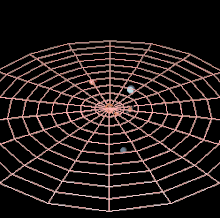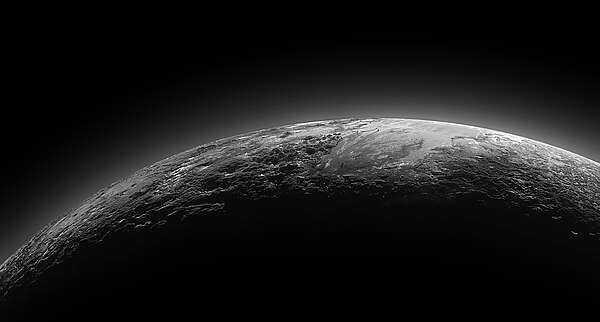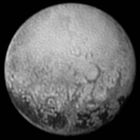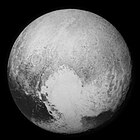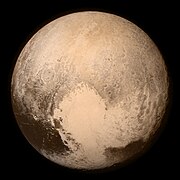Pluto (dwarf planet)
Pluto, designated (134340) Pluto, is a dwarf planet in the solar system below the orbit of Neptune. Its name is due to the mythological Roman god Pluto (Hades according to Greek mythology). At the General Assembly of the International Astronomical Union held in Prague on August 24, 2006, a new category called the dwarf planet was created, which includes Pluto. Later, in 2008, the IAU specified a new category for Pluto-like dwarf planets in orbit beyond Neptune, which it called plutoid. It is also the prototype of a category of trans-Neptunian objects called plutinos. Pluto has an eccentric orbit and highly inclined with respect to the ecliptic, which it travels approaching at perihelion to the interior of Neptune's orbit. It also has five satellites: Charon, Nix, Hydra, Cerberus and Styx, which are celestial bodies that share the same category.
Its great distance from the Sun and the Earth, together with its small size, prevents it from shining above magnitude 13.8 at its best moments (orbital perihelion and opposition), for which reason it can only be appreciated with telescopes at from 200 mm aperture, photographically or with a CCD camera. Even at its best it appears as a stellar-looking, yellowish, featureless point star (apparent diameter less than 0.1 arcseconds). It was not until 2015 when the New Horizons space probe passed over the planet and allowed its real appearance to be clearly appreciated for the first time.
Pluto was discovered on February 18, 1930 by American astronomer Clyde William Tombaugh (1906-1997) from the Lowell Observatory in Flagstaff, Arizona, and was considered the ninth and smallest planet in the solar system by the International Astronomical Union and by public opinion from then until 2006, although its belonging to the group of planets in the solar system was always the subject of controversy among astronomers. For many years there was a belief that Pluto was a satellite of Neptune that had ceased to be a satellite by reaching a second cosmic speed. However, this theory was rejected in the 1970s.
After an intense debate, and with the proposal of the Uruguayan astronomers Julio Ángel Fernández and Gonzalo Tancredi before the General Assembly of the International Astronomical Union in Prague, Czech Republic, it was unanimously decided to reclassify Pluto as a dwarf planet, requiring that a planet must have orbital dominance. Its classification as a planet was proposed in the draft resolution, but it disappeared from the final resolution, approved by the General Assembly of the UAI. Since September 7, 2006, it has the number 134340, granted by the Center for Minor Planets.
| Name | Orbital period | Masa | Radio | Place | Date | |
|---|---|---|---|---|---|---|
| Caronte | 153. | (1,52±0.06)×1021 kg | 606 km | United States Naval Observatory Flagstaff Station | 22 June 1978 | |
| Nix | 25 days | 5×1016 - 2×1018 kg | 46 km | Hubble Space Telescope | June 2005 | |
| Hydra | 38 days | 5×1016 - 2×1018 kg | 57 km | Hubble Space Telescope |
| |
| Cerbero | ? | ? | ? | Hubble Space Telescope | 28 June 2011 (confirmed 20 July 2011) |
History
Discovery
In the 1940s, Urbain Le Verrier used Newtonian mechanics to predict the position of Neptune after analyzing perturbations in the orbit of Uranus. Later observations of Neptune in the late 19th century led to astronomers to conjecture that another planet besides Neptune was disturbing the orbit of Uranus.
In 1906, Percival Lowell—a wealthy Bostonian who had founded the Lowell Observatory in Flagstaff, Arizona in 1894—began an intensive search program for the ninth planet, which he named Planet X. By 1909, he and William H. Pickering had suggested several celestial coordinates where such a planet might be found. Lowell and members of his observatory continued the search, with no results until Pickering's death in 1916. However, Lowell had unknowingly photographed it in plates of March 19 and April 7, 1915, where it appeared as a faint object. There are fourteen other known precovery observations, the oldest being the one made at Yerkes Observatory on August 20, 1915. 1909.
However, the search for Planet X was halted due to a ten-year legal dispute with Percival's widow, Constance Lowell, who wanted a portion of her husband's bequest to the observatory to go to her. In 1929, the new director of the observatory, Vesto Melvin Slipher, entrusted the search to Clyde William Tombaugh, a 23-year-old from Kansas who impressed him with his astronomical drawings.
Tombaugh's task was to take pairs of photographs of the night sky, then examine each pair to determine if any objects had changed position. To do this, he used a blinking microscope, a device that created an illusion of movement by rapidly moving two photographs over themselves, thus making it possible to detect changes in the position of objects or in the appearance of the images. On February 18, 1930, after almost a year of searching, he found an object that had moved on plates taken on January 23 and 29 of that year. A lower-quality photograph taken on the 21st helped confirm the motion. After the observatory obtained additional confirming photographs, news of the discovery was telegraphed to the Harvard College Observatory on March 13, 1930.
Name
The discovery made headlines around the world. Lowell Observatory, which had the naming rights for the new object, received more than 1,000 suggestions ranging from "Atlas" to "Zymal." Tombaugh urged Slipher to come up with a name before someone else stepped forward and did so. Constance Lowell first suggested "Zeus"; then "Percival"; and finally "Constance". None were taken into consideration.
The name "Pluto"—after the Roman god of the underworld—was proposed by Venetia Burney, an Oxford student with an interest in classical mythology, during a conversation with her grandfather Falconer Madan, a member of the Bodleian Library. He passed the name on to astronomer Herbert Hall Turner who, in turn, cabled his American colleagues with the proposal.
To choose the definitive name of the object, each member of the Lowell observatory was asked to vote for one of three proposals: "Minerva", which was already the name of an asteroid; "Cronos", which had a bad reputation for being proposed by the unpopular astronomer Thomas Jefferson Jackson See; and "Pluto". The latter finally received all the votes. The name was announced on May 1, 1930 and, after knowing it, Madan gave Venetia five pounds of reward. In the final choice of the name it helped the first two letters match the initials of Percival Lowell. An astronomical symbol is a representation of these letters:., Unicode U+2647. One other is ((![]() ), U+2BD3.
), U+2BD3.
The name caught on very quickly in popular culture. In 1930, Walt Disney was apparently inspired by him when he introduced Pluto, Mickey Mouse's canine companion, Pluto, although Disney animator Ben Sharpsteen was unable to confirm the truth of this. In 1941, Glenn T. Seaborg named a new chemical element "plutonium" after the name of the planet. Seaborg followed the recent tradition of naming discovered elements by the name of the new planets in the solar system. Thus, uranium was named after Uranus and neptunium after Neptune. Most languages use proper forms of the name "Pluto". Hōei Nojiri suggested for Japanese the translation "Meiōsei" (冥王星, "Star King of the underworld"), which was also taken by the Chinese and Vietnamese.
Nature of Pluto
Once discovered, Pluto's dim brightness and the inability to resolve its disk cast doubt on Lowell's idea of its being Planet X. In addition, the mass value was revised throughout the remainder of the century The first estimates were made by taking the supposed perturbations on Uranus and Neptune. In 1931, Pluto was estimated to have a mass similar to Earth's. Later, in 1948, a new estimate reduced it to equal that of Mars. In 1975, Dale Cruikshank, Carl Pilcher, and David Morrison of the University from Hawaii, calculated its albedo for the first time and found it to match that of methane ice. This meant that Pluto had to be quite luminous for its size and could not be more than 1% of the mass of Earth. Pluto's albedo has been found to be 1.4 to 1.9 times Earth's.
The discovery in 1978 of Charon, Pluto's first satellite, made it possible to measure its mass directly. It turned out to be about 0.2% the mass of Earth, too small to explain the discrepancies in Uranus's orbit. Subsequent searches for an alternative to Planet X failed. In 1992, E. Myles Standish used data from the Voyager 2 flyby of Neptune—during which the estimate of Neptune's mass was revised to lowers it by 0.5%, comparable to the mass of Mars—to recalculate its gravitational effect on Uranus. With the new figures, the discrepancies disappeared. Since then, most scientists agree that Planet X does not exist as Lowell described it. Lowell made a prediction of the orbit and position of Planet X that was fairly close to the Pluto's orbit and its position at the time of discovery. Ernest William Brown commented shortly after that it had been coincidence, an opinion corroborated by later studies.
Reclassification
Controversy
Since 1992, numerous bodies have been discovered in the same region of Pluto in the solar system, showing it to be part of the population of so-called Kuiper belt objects. This led to its status as a planet being controversial and many questioning whether or not it should be considered together with that population. Some museum and planetarium directors added to the controversy by omitting Pluto from their institutions' models of the solar system. The Hayden Planetarium, for example, reopened—in 2000, after a renovation—with a model of just eight planets. Almost a year later, he was a headline in some newspapers.
Because objects were being discovered whose sizes were increasingly closer to that of Pluto, it was argued that it should be reclassified as one of the Kuiper belt objects — in the same way that Ceres, Pallas, Juno and Vesta lost planet status after the discovery of many asteroids. In 1999 astronomer Brian Marsden, then director of the Center for Minor Planets, came to propose including it in the catalog of minor bodies assigning the number (10000). Finally, the idea was not accepted by the International Astronomical Union and it was the asteroid 1951 SY the one that received that number. Later it was given the name of Miriosto.
The controversy intensified again starting in 2001 with the relatively frequent discovery of Pluto-like objects in the outer solar system. In 2002, Quaoar, a trans-Neptunian object whose diameter is about 1,070 km, about half that of Pluto, was discovered. In 2003, at a distance of 100 au, Sedna was found, with a diameter of about 1,000 km.
On June 29, 2005, astronomers at Caltech announced the discovery of a new trans-Neptunian object, Eris, more massive than Pluto and the most massive discovered in the solar system since Triton in 1846. Both its discoverers and the press called it the tenth planet, although there was no initial agreement in the astronomical community as to whether it should be a planet. Other astronomers considered it the strongest argument for reclassifying Pluto as a minor planet.
Dwarf Planet
The debate reached its culmination on August 24, 2006 with a resolution of the UAI in which it established the official definition of a planet. According to it, there are three conditions for an object to be considered a planet:
- The object must be in orbit around the Sun.
- The object must be massive enough for its gravity to round it up. More specifically, its own gravity must lead to hydrostatic balance.
- The object must have cleaned the vicinity of its orbit.
Pluto does not meet the third condition because its mass is only 0.07 times the mass of the other objects in its orbit—for comparison, Earth's mass is 1.7 million times that of its orbital region —, so the IAU also decided that the bodies that meet only the first two criteria would be called "dwarf planets". Thus, on September 13, 2006, Pluto, Ceres and Éris were classified in the new category.
There has been some resistance in the astronomical community against the reclassification. Alan Stern, principal investigator of the New Horizons mission, publicly ridiculed the IAU resolution stating that "the definition sucks for technical reasons ». Stern's explanation was that Earth, Mars, Jupiter and Neptune—all of which share orbit with asteroids or trans-Neptunian objects—would be excluded under the new definition. Furthermore, he argued that the large satellites, including the Moon, should be also considered planets. Finally, he mentioned that, because less than five percent of astronomers voted, the decision was not representative of the entire astronomical community. Marc Buie, then a member of Lowell Observatory, expressed his opinion in against the new definition on their website. Other astronomers have supported the IAU. Michael E. Brown, discoverer of Eride, said that "through all this madcap circus procedure, the correct answer was somehow stumbled upon. It was time. Science eventually corrects itself, even when strong emotions are involved."
Popular reception of the IAU decision was mixed, and while many accepted it, some tried to overturn it with online petitions urging the IAU to consider restoring planet status. A resolution introduced by some members of the California State Assembly half-jokingly called the decision "scientific heresy". The New Mexico House of Representatives passed a resolution honoring Tombaugh, a longtime resident of the state, in declaring that Pluto will always be considered a planet from the time it is visible from the state, and that March 13, 2007 will be Planet Pluto Day. similar resolution in 2009 according to which Pluto was "unfairly downgraded to a dwarf planet" by the IAU. to Pluto as a planet and will continue to do so regardless of the IAU's decision.
Several researchers supporting both sides of the debate met August 14-16, 2008 at the Johns Hopkins University Applied Physics Laboratory for a lecture that included face-to-face discussions about the current definition of a planet. of the IAU. Titled "The Great Planetary Debate", the conference subsequently issued a press release stating that scientists could not reach agreement on the definition of a planet. Prior to the conference, On June 11, 2008, the IAU announced in a press release that the term "plutoid" would be used to refer to Pluto and other trans-Neptunian objects—whose semi-major axes are larger than Neptune's—that have sufficient mass to achieve the shape spherical.
Origin
The origin and nature of Pluto had long puzzled astronomers. A first hypothesis proposed that it was a satellite that had escaped from Neptune, taken out of orbit by Triton. This idea was later rejected after dynamical studies showed it to be impossible: the paths of Pluto and Neptune are never close.
Pluto's true place in the solar system began to be revealed starting in 1992, when astronomers began to find small icy objects beyond Neptune similar to Pluto not only in orbital characteristics, but also in size and composition. This trans-Neptunian population is thought to be the source of many short-period comets. Pluto is now the largest member of the Kuiper belt, a stable region between 30 and 50 au from the Sun—the more massive Eris belongs to the scattered disk objects, a group sometimes considered a separate group.
In 2011, the survey of Kuiper belt objects down to magnitude 21 was nearly complete and no Mercury-sized objects were expected to be discovered within 100 au of the Sun. Like other belt objects de Kuiper, Pluto shares cometary characteristics; for example, the solar wind is gradually wearing away its surface and sending it into space. It has been claimed that if Pluto were as close to the Sun as Earth, it would develop a tail just like comets. This claim has been challenged on the grounds that the escape velocity is too high for this to happen.
Although Pluto is the largest Kuiper belt object discovered, Triton, which is similar both geologically and atmospherically and is likely a belt object captured by Neptune, is slightly larger. Eris, similar in size, belongs to to the population of scattered disk objects.
Many Kuiper belt objects are in a 2:3 orbital resonance with Neptune just like Pluto, which is why they have been referred to as "plutinos", from Pluto's English name.
Orbital characteristics
Orbit
Pluto's orbit is highly eccentric, and for 20 of the 248 years it takes to orbit it, it is closer to the Sun than Neptune.
It is also much more inclined with respect to the ecliptic plane than any of the planets in the solar system, its inclination being 17°, so there is no danger of a collision with Neptune. When the orbits intersect, they do so near the ends so that, perpendicular to the ecliptic, they are separated by a great distance.
Pluto last reached perihelion in September 1989 and continued to move inside Neptune's orbit until March 1999. It is currently receding from the Sun and will no longer be any closer to the Sun than Neptune until September 2226.
Rotation
Pluto's period of rotation is equal to 6.39 Earth days (153 hours and 21 minutes). Like Uranus, Pluto rotates lying on its side in its orbital plane, with an axial inclination of 120°, therefore, its seasonal variation is extreme. During the Plutonian solstices, a quarter of the surface is continuously day while another quarter is continuous night.
Physical characteristics
Geography
Coordinate system and rotational elements
The International Astronomical Union (IAU), through the Working Group for the definition of Cartographic Coordinates and Rotational Elements of Planets and Satellites, defined in 1979 the poles and geographic coordinates of Pluto, which, as a planet that was considered at that time, its north pole was defined as oriented in the same sense as Earth's, on the north side of the invariable Plane of the Solar System, and that made its rotation retrograde. The zero meridian was arbitrarily located at the epoch B1950.0. The only update to this definition took place in 1991 when the zero meridian was defined as that located on the Pluto-Charon axis and on the face facing the satellite.
However, in the literature on Pluto these definitions were ignored, and the direction of the pole aligned with the angular momentum vector was used according to the right-hand rule, that is, the opposite of north was defined as north. defined by the IAU, thus giving a direct meaning to the rotation of the planet. In the same way, instead of geographic longitude, various definitions of rotation phases calculated from a certain epoch given in Julian date were used, and referred to events such as maximums and minimums of light curves or relative positions of Charon with respect to Pluto. The difficulty with these definitions is that the data from different articles cannot be compared if they do not refer to the same periods and to the same events. When it was necessary to define a longitude, it was defined as planetocentric, increasing towards the east from the zero meridian, instead of planetographic, increasing in the opposite direction of rotation, which is the IAU recommendation. Starting in 2000, with the rise of computer programs for calculating ephemeris, which return calculations in the official IAU coordinates, these began to be more widely used and both systems coexisted in the work on Pluto.
In 2006, with the reclassification of Pluto as a dwarf planet, the IAU definition that applied to it became the one related to Minor Bodies, which defines the positive pole as the one aligned with Pluto's angular momentum vector according to the right-hand rule and a definition of planetocentric longitude, that is, the same coordinate system that had been widely used before. For convenience, the positive pole is still called the north pole.
Geology
Methane ice (CH4), brighter with an albedo of 0.65, is found in certain areas of the surface above 1.5 km altitude. In Pluto's equatorial zones, between 20º N and 10 S, within the Cthulhu region, it occurs on the summits and north-facing slopes of the Pigafetta Montes and Elcano Montes, which are 4 km above altitude. average of Pluto and between 2.5 and 3.5 km from the surrounding surface, giving rise to a landscape similar to Earth's snowcapped peaks, and crater rims, Edgeworth, and scarps, Virgil Fossa. To the north, at Venera Terra and Viking Terra, it is also found on crater walls, but this time preferentially on those facing south. Also the summits of Al-Idrisi Montes and Tenzing Montes present high-altitude methane frost.
The presence of this layer of methane ice in elevated areas is due to the fact that the relative concentration of this compound in Pluto's atmosphere is greater at a height of 4 km with respect to the surface, giving rise to an area of greater temperature, by absorption of solar radiation since it is a gas that generates an important greenhouse effect, than on the surface. The surface remains the same cold regardless of height since the atmosphere is too thin to affect it. Therefore, the air closest to the surface cools and flows downslope, unlike on Earth, allowing methane at altitude to condense on tops and elevated areas of mountains and craters. In the Cthulhu region, despite its low albedo of 0.1, its nighttime surface temperature is so cold, 40-42 K, that it allows an amount of frost to accumulate that daytime sublimation cannot compensate. This mechanism would also explain the jagged texture of the Tartarus Dorsa region, a region consisting of massive methane deposits found almost exclusively at elevations greater than 2 km above Pluto's mean radius. This process does not occur in areas whose surface is mostly composed of nitrogen ice (N2), such as Sputnik Planitia, because nitrogen sublimation is capable of cooling the atmosphere up to a height of several kilometers above sea level. the surface.
Atmosphere
Pluto has an extremely thin atmosphere, made up of nitrogen, methane, and carbon monoxide, which freezes and collapses onto its surface as the planet moves further from the Sun. It is this evaporation and subsequent freezing that caused the variations in the planet's albedo, detected by means of photoelectric photometers in the 1950s (Kuiper et al.). As the planet approached, the changes became smaller, diminishing when it was found at orbital perihelion (1989). These albedo changes are expected to repeat themselves, but in reverse, as the planet moves away from the Sun towards its aphelion.

Satellites
At first it was considered that Pluto did not have satellites (a case similar to Mercury and Venus). In 1978 it was when the first satellite of him (Caronte) was discovered. Of all the moons in the solar system, Charon is the largest compared to its host planet, meaning no other moon is so close in size to the planet it orbits. The size so similar that Pluto and Charon have makes the double planet effect appear, that is, the center of the orbits around which both bodies move is not located inside either of them, in opposition to the system &# 34;satellite-planet" which is the case of the Earth and the Moon, in which the center is located approximately 1700 kilometers below the Earth's surface.
Today it is known that, in addition to Charon, there are four other satellites that orbit Pluto: Hydra, Nix, Cerberus and Styx. They are all much smaller than Charon. Their provisional names were S/2005 P 1, S/2005 P 2, S/2011 P 1, and S/2012 P 1, respectively.
Charon
Charon is the first discovered satellite of Pluto. It is 1,208 kilometers in diameter and 19,640 kilometers from the planet. Since it was discovered in 1978, they have been considered a double planet, since their masses are similar and the barycenter is outside of Pluto, the body with the greatest mass. In this way both orbit around that point. It seems as if they were joined by an invisible bar and revolved around a center located on that bar or axis, closer to Pluto, since it has seven times the mass of Charon.
After the General Assembly of the UAI in 2006, the category of Charon is uncertain. It is considered a possible dwarf planet candidate, but the definition does not make it clear how to distinguish between a satellite or a binary system, so it is still considered a satellite of the dwarf planet Pluto.
Over time, gravity has slowed the rotations of Charon and Pluto, which are unique in the solar system, so they now always present the same face to each other.
Nix and Hydra
On October 31, 2005, the Hubble Space Telescope announced the possible discovery of two additional smaller satellites. These moons were observed in May 2005 and confirmed to exist in June 2006. They have been given the names Nix (provisional name S/2005 P1) and Hydra (provisional name S/2005 P2).
The name of both satellites was chosen jointly, since their initials NH pay tribute to the New Horizons space probe, which took off in 2006 bound for Pluto. Preliminary observations are consistent with both bodies orbiting in the same plane as Charon, and at distances two and three times greater. Nix is 42 km long and 36 km wide, while Hydra is 55 km long.
In 2015, a new study made with all the available data from the Hubble Space Telescope made it possible to find out that Nix and Hydra are not rotating on their axes, but that they do so in a chaotic way while they orbit around Pluto and its main satellite, Charon.
Cerberus and Styx
On July 20, 2011, the discovery of Pluto's fourth satellite, P4 (S/2011 P 1), was announced, also thanks to the Hubble Space Telescope, whose orbital period around the dwarf planet is 31 days. From June 29 to July 9, 2012, Pluto's fifth satellite, S/2012 (134340) 1, or P5, was detected in separate images. It is estimated to be irregular in shape, between 10 and 25 kilometers in diameter. It is in a 95,000 km diameter circular orbit around Pluto, possibly in the same plane as other known Pluto moons.
On July 2, 2013, these satellites received names related to Hades and the Underworld: Cerberus (three-headed dog guardian of the underworld) and Styx (river that separates the earth from the underworld), respectively. With the arrival of the New Horizons probe, it was possible to have better images of both satellites, and it was discovered that they have a size of around 12 kilometers. Cerberus has two lobes, probably formed by the union of two satellites.
Their orbits are very outer, so they are satellites of the Pluto-Charon system, and their orbits are stable, since they are in a solution of the four-body problem (far orbits around the barycenter of the system). The discovery of the fifth satellite offers additional clues to how the Pluto system formed and evolved. The most favored theory is that all the moons are relics of a collision between Pluto and a large Kuiper Belt object billions of years ago.
Exploration
New Horizons Mission
Pluto was the second dwarf planet to be visited by a space probe, after Ceres. On July 6, 2015, NASA's New Horizons mission was nine million kilometers (9,000,000) from He, on July 13, was 768,000 kilometers from the surface, obtaining the most detailed image of the celestial body until its closest expected approach that took place on July 14, 2015. Scientific observations began five months before the approach and they continued at least a month after it, with the objective of characterizing the geology and morphology of Pluto and some of its moons, as well as studying the composition of its surface and its atmosphere.
Pluto in fiction
- In the series of novels Myths of Cthulhu by H. P. Lovecraft, Pluto is described as a world inhabited by an alien species not native to this planet, known as Mi-go, which calls "Yuggoth" to the Pluto planet.
- In the series of Japanese animé Sailor Moon, one of the warriors responsible for protecting the solar system, "Sailor Pluto" comes from Pluto.
Image gallery
|
|
|
|
|
Video
Contenido relacionado
(29) Amphitrite
STS-61-B
Right ascension






